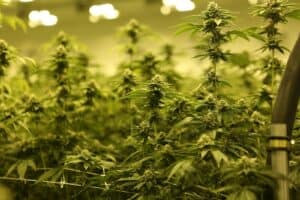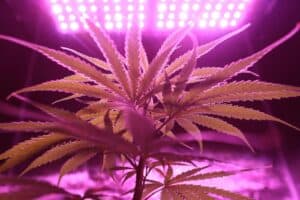Topping cannabis plants is one of the most important growing techniques that involves removing the top growth of the plant to encourage branching and increase harvests. Being able to understand this technique as a beginner grower will prove to be an immense help in your cultivation practice.
Key Takeaways
- Topping encourages side branching, several colas, and higher yields.
- Timing and techniques also matter when it comes to topping cannabis plants without stressing them too much.
- This method works well during the vegetative stage when the plant grows healthy and shows optimal results.
What Is Cannabis Topping and Why Should You Do It?
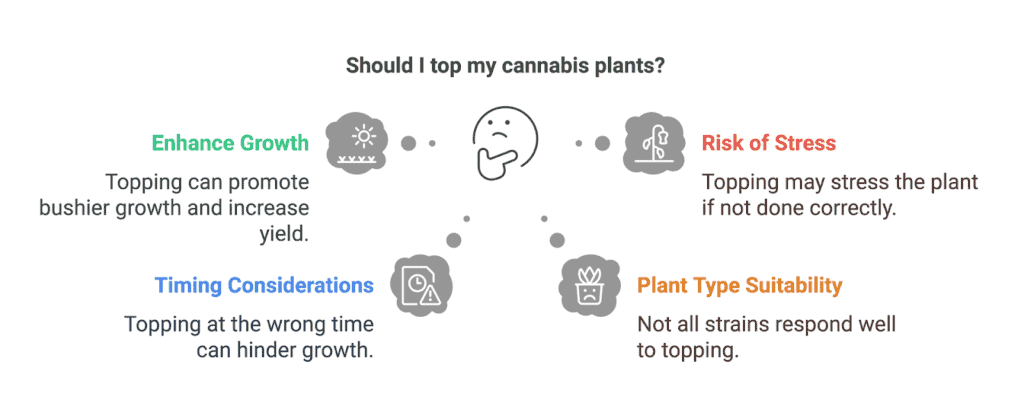
Topping cannabis is a method of cutting off the main growth tip of a plant to promote lateral growth and multiple colas.
It prevents the natural apical dominance effect in a plant whereby the dominant main stem elongates, pushing all other branches further away and suppressing their development. It redistributes the plant’s energy in favor of branching growth and promotes an increased number of bud sites that in turn promote overall yield.
Benefits of Topping Cannabis Plants
- It makes the plant develop horizontally.
- It encourages fullness instead of developing a Christmas tree appearance.
- It ensures proper penetration of lighting as well as increased airflow.
- This results in a greater number of buds and main colas.
Other than the physical improvement of the plant structure, this process ensures that the plant utilizes more light and nutrients efficiently. This subsequently translates to greater yields.
When Is the Best Time to Top Cannabis Plants?
- Vegetative Stage: It works well when the plant has at least 4–5 nodes.
- Early Vegetative Growth: Not topped too early, lest the health of the plant decline.
- Top the plant before it flowers for optimal benefit.
How Do You Top a Cannabis Plant Correctly?
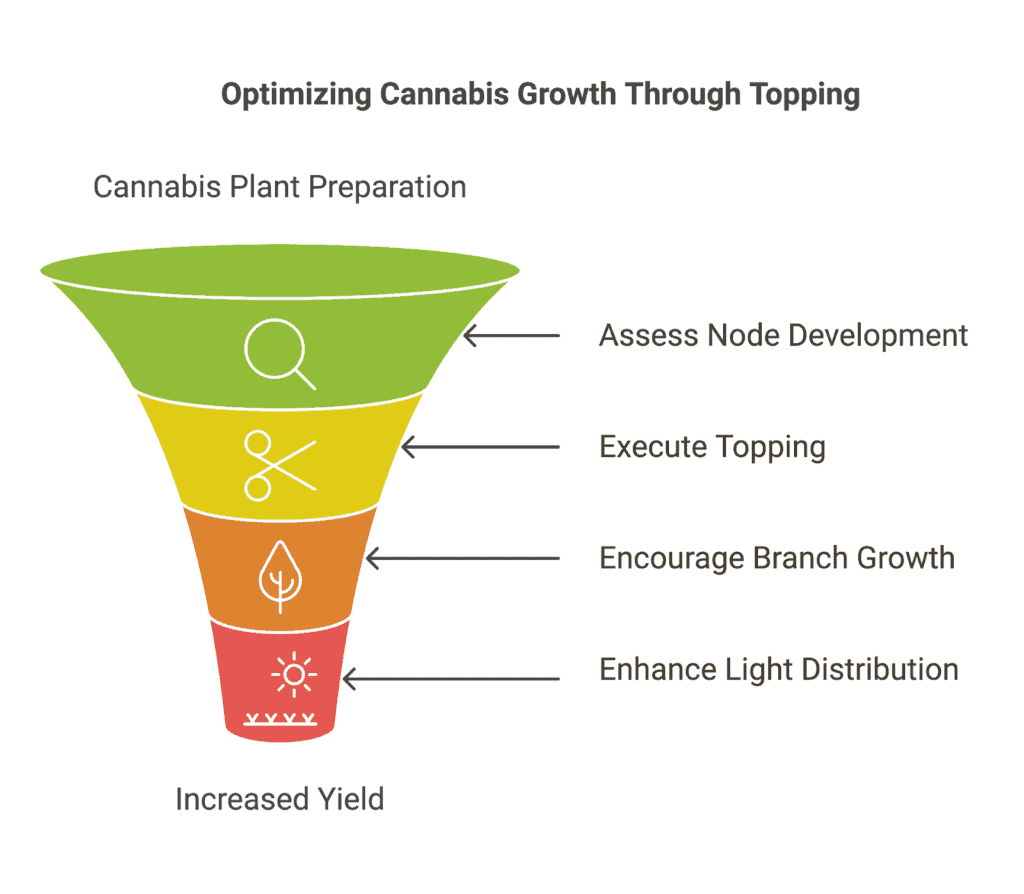
Topping cannabis is a precise process that should be done at the right time so as not to harm the plant.
Begin by locating the plant’s most prominent growth tip, which often sits above its highest set of leaves. Using sanitized scissors, clip off the leading tip of the main stem immediately above a node. This helps the plant produce two new stems.
Steps to Topping Cannabis Plants
- Wait until it has at least four nodes.
- Always use sharp scissors that are sterilized to avoid any infections.
- Always cut above the node to trigger two new stems.
- Monitor the health of the plant after topping to see if it will recover.
Monitoring the plant post-topping ensures that it is recovering well and is adapting to its new growth pattern without stress.
Common Mistakes to Avoid When Topping Cannabis
- Topping Too Early: Topping the plant when it has fewer than four nodes may hinder growth.
- Using Dirty Tools: This may increase the chances of infections.
- Over-Topping: Do not top the plant multiple times in quick succession.
These mistakes can cause stress to your plant, decreasing its yields or even hurting your cannabis plant’s growth in a permanent manner.
How Topping Affects the Look and Yield of Your Cannabis Plant?
Topping reverses the pattern of growth that the plant may have had into a bushier form rather than the Christmas tree shape. Additional bud sites, as well as an increased distribution of light around the plant, result from topping.
Comparison of Topped vs. Untopped Plants
| Aspect | Topped Plant | Untopped Plant |
| Shape | Bushier with lateral growth | Tall and narrow |
| Bud Sites | Multiple colas and buds | Single main cola |
| Light Penetration | Evenly distributed across branches | Concentrated at the top |
| Yield | Higher yields | Lower yields |
Better shape and multiple bud sites in topped plants make them more productive in the production of quality cannabis compared to untopped plants.
Role of Plant Training in Topping
Topping can be used in combination with other plant training techniques to achieve maximum yields. Low-stress training, for example, causes branches to grow outward, making even more bud sites, and topping off the top growth tip during a process.
These training methods enhance the architecture of the plant, increasing its ability to expose light and air, leading to more healthy and radiant growth.
How Does Topping Compare to Fimming and Other Techniques?
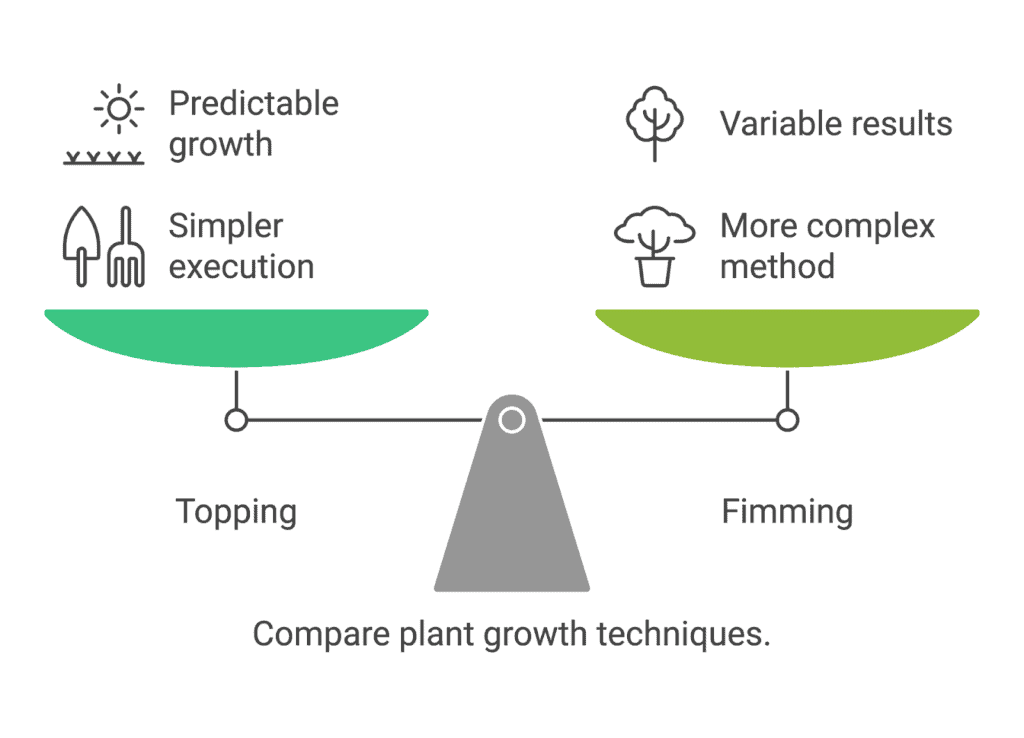
Topping is a plant training technique that involves cutting off the plant’s main growth tip to encourage lateral growth. This process helps cannabis plants grow bushier and improves light distribution for better overall yields.
Topping vs. Fimming
- Topping: Topping removes the growth tip of the main stem. Topping leaves produces two new branches.
- Fimming: Fimming partially removes the growth tip of the plant but leaves up to four new branches instead of two.
Both techniques work to increase the production of buds, but topping is more accurate and can easily result in irregular growth if not done correctly.
Advantages of Topping Over Other Techniques
- Accuracy: Topping facilitates controlled growth, which is perfect for small grow rooms.
- Ease: It is less complicated to do than other advanced techniques such as super cropping.
- Flexibility: It can be combined with other techniques such as LST.
One of the most common techniques used by new growers is topping because it is easy and has been proven to increase yields.
When to Combine Topping with Other Methods?
- Combine with LST to spread out branches.
- Pair with defoliation for better light penetration.
- Use with super cropping for advanced cultivation setups. Every technique has its strengths, but combining them strategically can maximize the potential of your cannabis plants.
What Should You Know Before Topping Your Cannabis Plants?
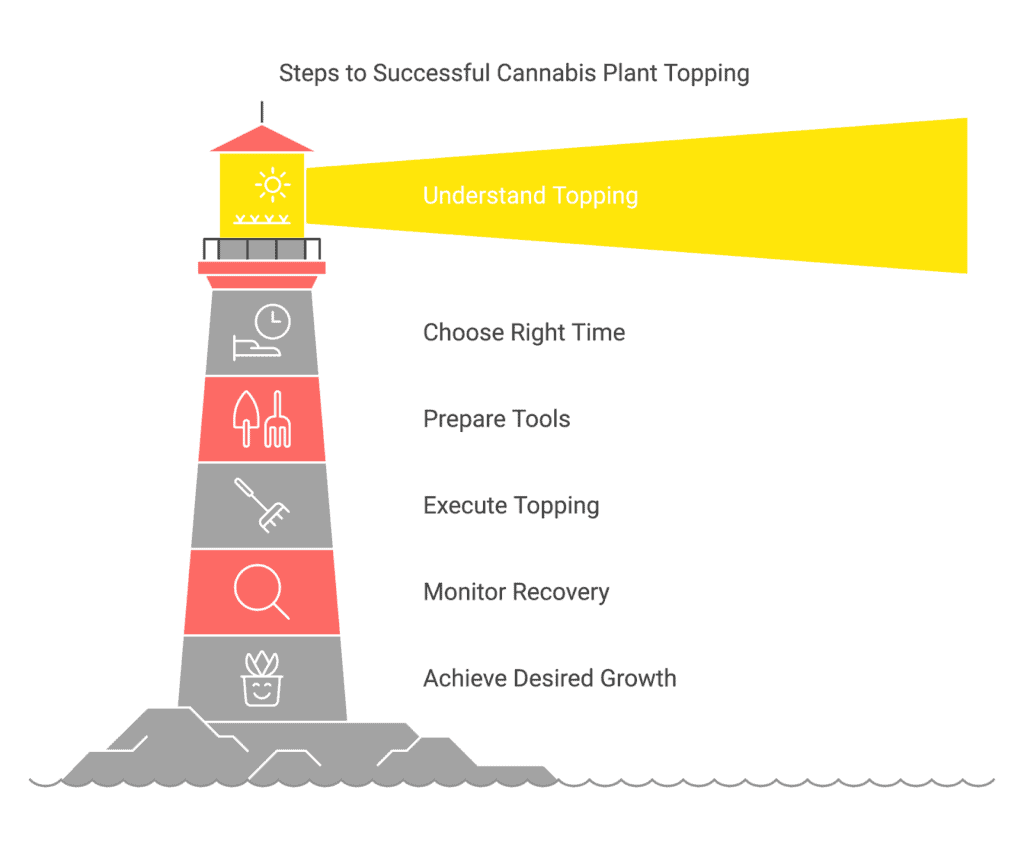
Topping your cannabis depends on the strain, growth stage, and health of the plants.
Factors to Consider When Topping Cannabis
- Type of Strain: The sativa strains tend to do well with topping more than some of the indica strains.
- Plant Health: Top only healthy, growing cannabis plants.
- Growing Environment: Grow room conditions have to be optimal in order to prevent additional stress.
Topping enhances the form of the plant and its health in cannabis, but topping must meet the right time and conditions for it to be successful.
Recovery and Care After Topping
- Nutrients: Provide enough nutrients to support new growth.
- Watering: Avoid overwatering when the plant recovers.
- Monitoring: Monitor the plant for stress or slowed growth.
Proper steps taken after topping ensure that the plant will recover quickly and thrive during its vegetative stage.
How to Troubleshoot Problems After Topping?
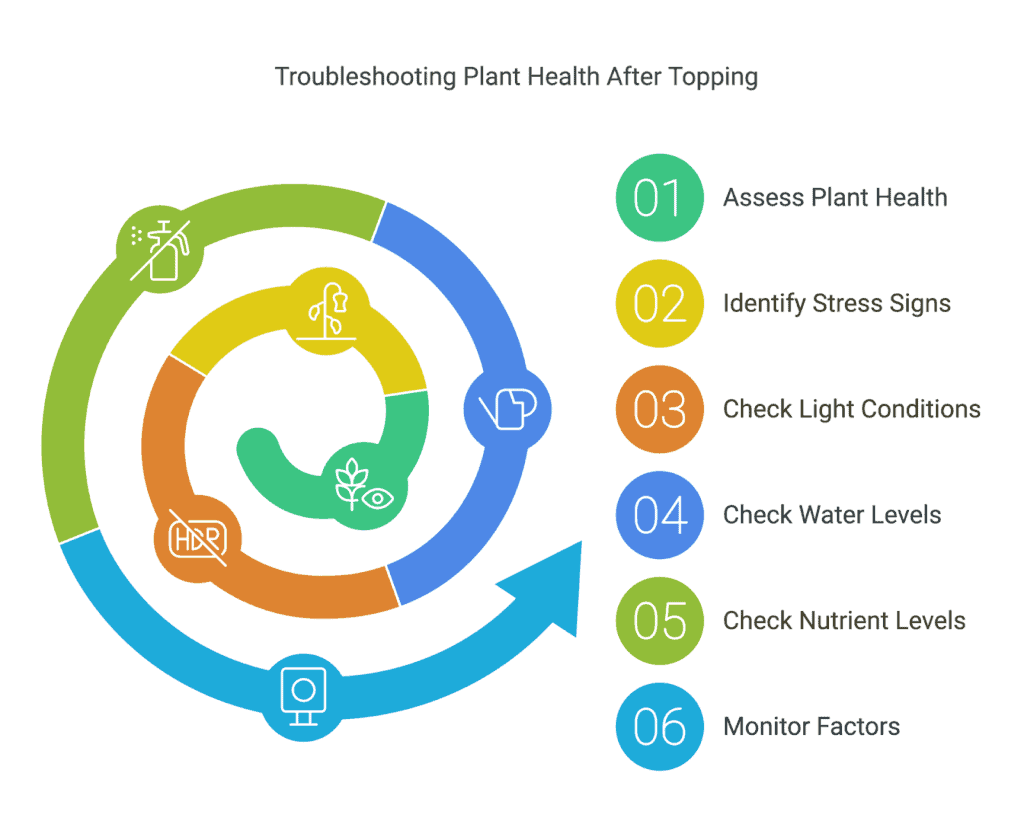
Even with the best care, problems can arise after topping. Knowing and solving these problems ensures your cannabis plants recover effectively.
Identifying Stress in Topped Cannabis Plants
- Slowed Growth: If the plant starts growing slower, it may be recovering from shock.
- Wilted Leaves: This can indicate overwatering or poor nutrient balance.
- Discoloration: Yellowing leaves could mean a lack of nitrogen or light stress.
Stress management is the key to making sure topped cannabis plants grow stronger and healthier.
Solutions to Common Topping Issues
- Nutrient Deficiency: Feed according to schedules and ensure proper nutrients.
- Overwatering: Water only when the soil dries up between watering.
- Lighting: Ensure the distance between the light source and the plant is sufficient for energy to help recover.
Effective troubleshooting can be the difference between a struggling plant and a thriving one.
Conclusion
Topping marijuana plants is an easy yet effective technique that can increase your harvest while sculpting your marijuana plants. You will encourage lateral growth and increase the number of bud sites by cutting off the top growth tip, enhancing your harvesting crop. It is important to know the proper time and methods when growing for the first time.
Mastering the art of solving such issues can ensure thriving, healthy plants.
Frequently Asked Questions
What is topping, and why do cannabis growers use this technique?
Topping involves cutting off the top of the plant above a leaf node. This encourages the plant to grow laterally, creating more colas and improving the shape of the plant. Cannabis growers use this method to maximize yields during cultivation.
When should a marijuana plant be topped during its growth cycle?
Cannabis plants should have at least 5 nodes before topping. Start topping during the vegetative stage to allow recovery before the flowering stage. Ensure the plant looks healthy before attempting to top.
How does topping benefit cannabis cultivation?
Topping can help open up the plant, encourage lower branches to grow, and improve light penetration. It is a key plant training technique that promotes cannabis growth and creates twice as many branches for flowering.
What should growers avoid when attempting to top a cannabis plant?
Growers should avoid topping too early or aggressively, as it can stop the plant from growing properly. Ensure parts of the plant are mature enough to handle the stress and allow recovery time for healthy growth.
Are there alternatives to topping for cannabis growers?
For those who don’t want to top, low-stress training (LST) is a good alternative. LST shapes the plant without cutting, encouraging branches to grow outward and improving cannabis cultivation results.







